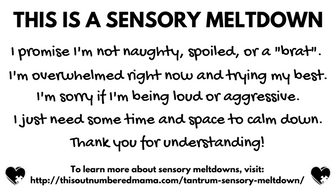



An autistic meltdown will occur with or without an audience. Tantrum behaviour will usually stop when the parent ignores the behaviour, when the child is removed from a public space where the behaviour is occurring, or when the child gets whatever it is they want (although this is not necessarily the best way to deal with tantrums). For someone with autism, when they reach the point of sensory, emotional, and information overload, or even just too much unpredictability, it can trigger a variety of external behaviours that are similar to a tantrum (such as crying, yelling, or lashing out), or it can trigger a complete shutdown and withdrawal.Ģ)Tantrums need an audience. An autistic meltdown on the other hand is all about being overwhelmed. Either the frustration at not getting what they want, not being able to do what they want, or even not being able to communicate what they want properly. While tantrums in young children can be more frequent when they are tired, hungry or not feeling well, they are always goal oriented. A tantrum in a young child typically stems from frustration from not getting what they want in that moment: wether it is a toy, being able to button up their own shirts, or not wanting to go to bed . How can you tell an autistic meltdown from a tantrum?ġ)Goal oriented vs overload. Of course children with autism can also have classic temper tantrums, but understanding the difference is important because tantrums need one kind of response, but that same response will only make things worse for a person have an autistic meltdown from being overwhelmed by sensory stimuli. Tantrums slowly go away as a child grows up, but meltdowns may never go away. A tantrum is willful behaviour in younger children and therefore can be shaped by rewarding desired behaviours, whereas a meltdown can occur across a lifespan and isn’t impacted by a rewards system. While they may look similar in external behaviour, it’s important to understand the difference between the two. Many parents and caregivers have witnessed the fireworks of anger and emotion from a person with autism, and from the outside they look exactly like the tantrums of young children.


 0 kommentar(er)
0 kommentar(er)
